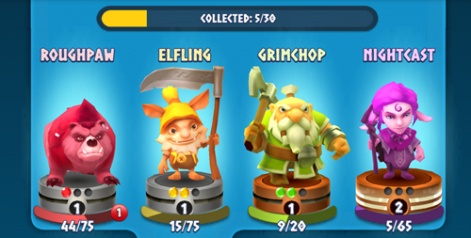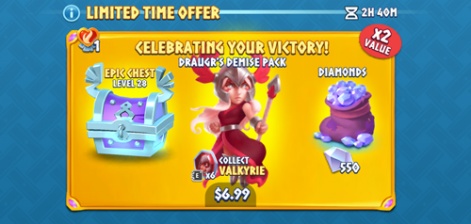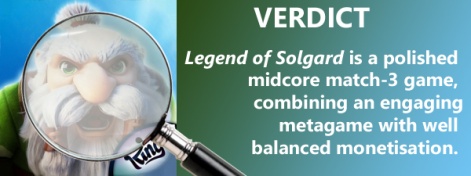Welcome to The In-App Purchase Inspector– our regular look at free-to-play mobile game monetisation from the consumer's perspective.
In each instalment, we consider how well a developer has designed its in-app purchase retailing to work alongside the overall gameplay and metagame experience.
This time we're looking at the Snowprint Studios-developed and King-published midcore lane-based, turn-based, match-three game Legend of Solgard.
From Saga to Legend
Unsurprisingly, King knows pretty everything there is to know about match-three games. Five years on, Candy Crush Saga is still generating over $900 million in annual revenue.
But that doesn’t mean its latest match-three Legend of Solgard has had a smooth gestation.
For one thing, it was developed by Swedish start-up Snowprint Studios - its debut game in fact - and has been in soft launch testing for over a year.
That suggests a lot of live iterative development and indeed looking back at early videos shows both gameplay and art changes over that period, although less than you might perhaps expect given the duration.
And when it comes to the in-game economy, most elements are as expected.
Rare, Epic and Legendary creatures are a key element for engagement with the long-term metagame.
There’s Gold, the soft currency, and Diamonds, the hard currency. There’s also an energy system, which feels a little dated these days but remains an effective gating mechanic to stop players burning through content.
When it comes to more sophisticated retention mechanics, the lure of Rare, Epic and Legendary creatures are a key element for engagement with the long-term metagame, and - if you want to attempt to buy your way to such creatures through the random drops of loot boxes - monetisation too.
Layering complexity for interesting choices
Aside from a creature’s rarity, each is defined by one of six races - Warrior, Beast, Small Folk, Wyrm, Wight and Spirit. Each creature is also colour-coded - red, yellow, green and purple.
The races don’t match to individual colours, with each creature seemingly assigned a random colour. The colours do matter however as you can only have four creatures in your team, one of each colour.

In this context, an important levelling resource is Dust, which is defined by colour, and spent alongside Gold as you level up your creature’s special abilities.
It will be interesting to see how quickly players burn through content in terms of the levels and creature unlocks.
You also collect Gems for each creature, which are spent improving their Critical Chance, Merge Bonus and Block Chance abilities. Plus there’s a crafting-based gear system, which allows each creature to equip up to two Idols, which effectively work as stats boosts.
This multi-layered upgrade system all feeds into each creature’s eight stats, which are where the improvements in terms of special abilities, gems and idols are represented.
All-in-all then, Legend of Solgard comes across as pretty complex in terms of its creatures mechanics, especially given there are currently 30 to collect, no doubt with more to follow over time.
You unlock the first four playing through the tutorial. The remaining 26 are unlocked as you grind or buy the required character gems.
Yet, the more you play the game, the more intuitive everything slowly becomes. And compared to the likes of hardcore mobile RPGs, Legend of Solgard’s metagame is fairly simple in terms of the number and depth of its variables.
Certainly, it will be interesting to see how quickly players burn through content in terms of the levels and creature unlocks, and hence how quickly King and Snowprint release large content updates.
Heading into the store
In terms of providing value for money, there’s more than enough going on in the early stages of Legend of Solgard for players not to worry too much about spending anything.
There are the usual daily log-in rewards and more rewards are provided for completing your daily quests. These are designed to drive strong retention rates. The game even gifts you 250 diamonds (worth around $3) for just following a prompt to check out the store (or not!).

If you do want to spend, the subscription offer of 180 diamonds upfront plus 60 diamonds daily for 30 days - 1980 diamonds in total for $6.99 is clearly the best option.
The nearest comparable option is 1250 diamonds for $13.99, although with the subscription, you do have to login daily for all of the 30 days to get the full reward.
Another nice, early offer for those who are interested is a victory pack, which grants 55 diamonds, a level 28 Epic chest and 6 Valkyrie gems, also for $6.99.

Other monetisation options include refilling energy, which cost 250 diamonds (around $3) for a full refill, and buying Raid tickets. These are all backed by the usual hard currency option of buying increasingly large amounts of diamonds as in-app purchases.
Another winner?
In conclusion, Legend of Solgard makes the most of King’s experience in running very successful match-three games.
It provides a well-balanced and generous initial experience, and one which integrates best practice when it comes to engaging and retaining players with strong gameplay and a clear metagame based around unlocking and levelling up new creatures.
It doesn’t offer the depth of niche Asian mobile RPGs of course, but as a game that could appeal to audiences spanning Candy Crush to Puzzle & Dragons, Legend of Solgard hits the spot.






















